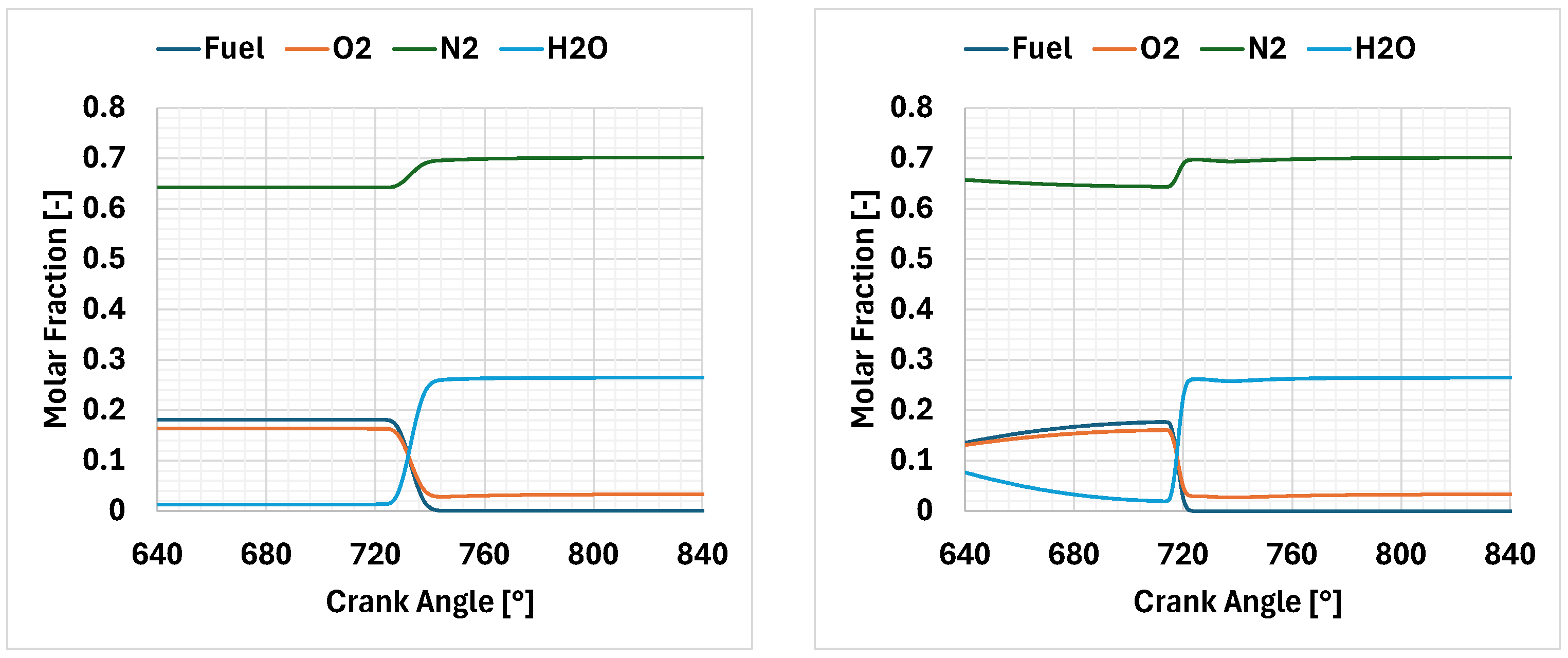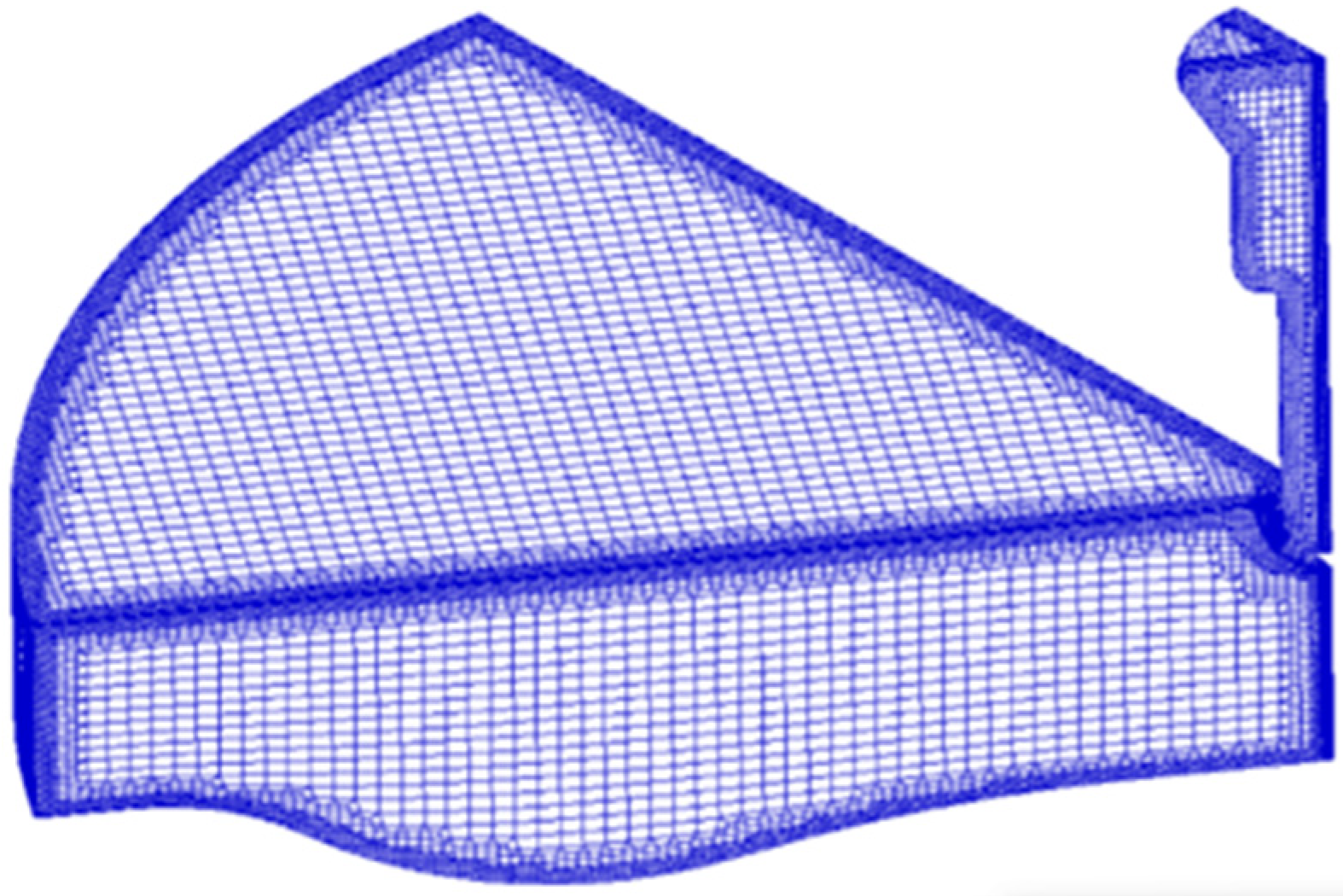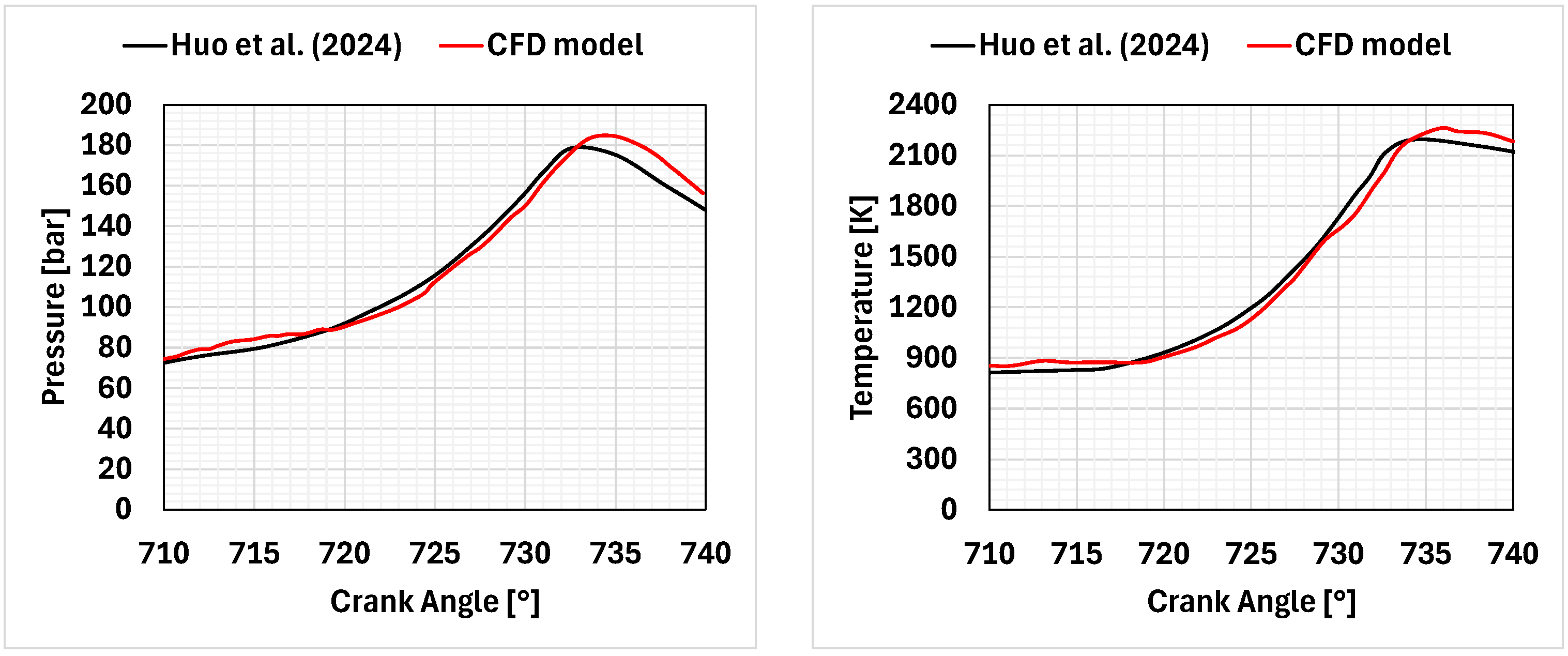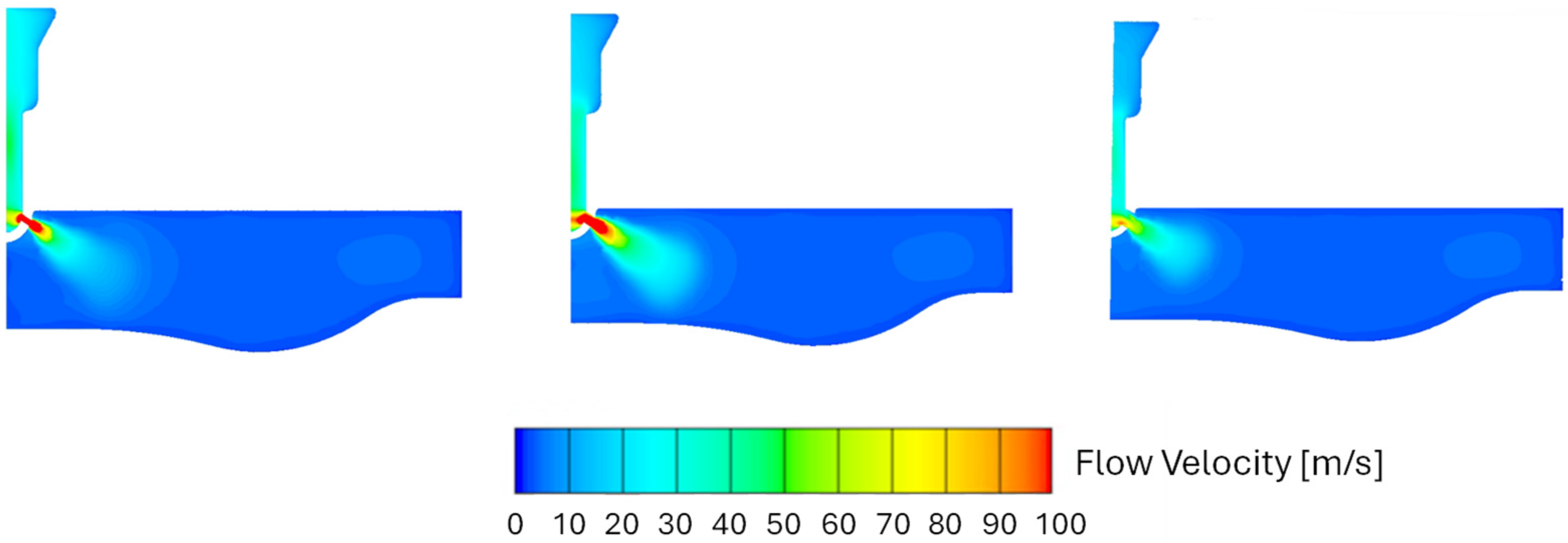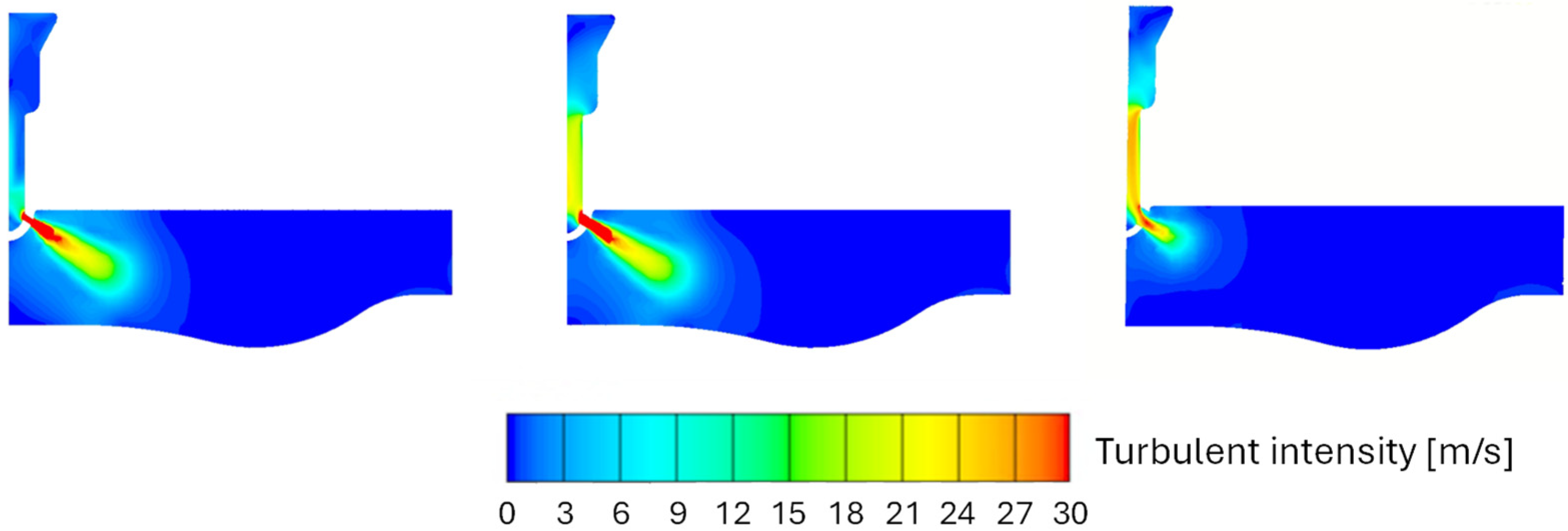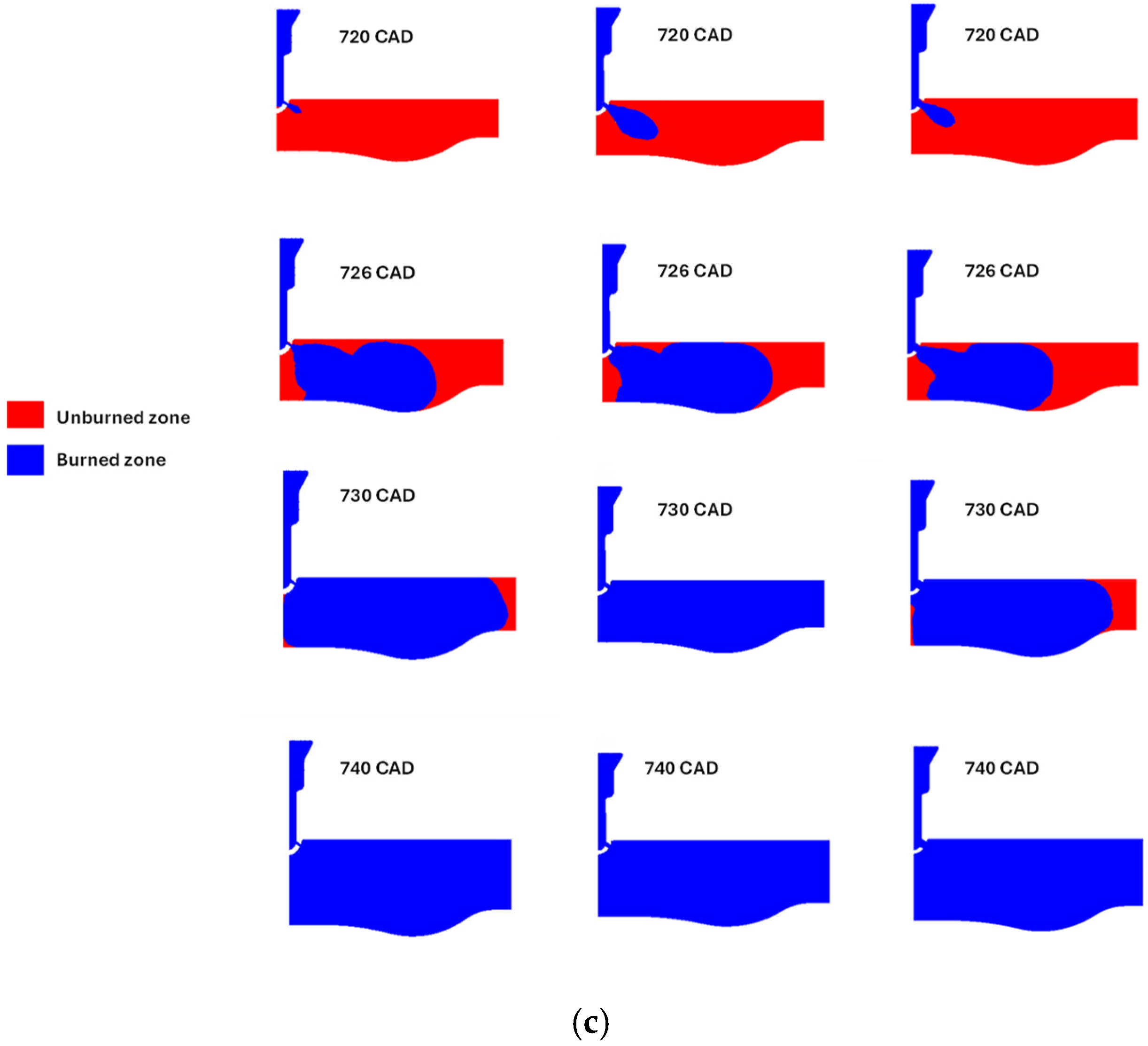1. Introduction
Recently, due to the significant concentrations of CO
2 in the atmosphere, the demand for carbon-free fuels for internal combustion engines has surged. Specifically, ammonia [
1,
2] can be utilized either as a standalone fuel or as a means of transporting energy for hydrogen generation [
3]. Conversely, ammonia poses significant risks to human health. Additionally, it can adversely affect the environment, particularly under windy and arid conditions, although its high volatility facilitates atmospheric dilution. Furthermore, the laminar flame speed of ammonia is quite low [
4], and its high ignition temperature complicates the combustion process. However, these issues can be addressed by introducing hydrogen [
5,
6], a strategy that is also applicable to standard fuels. Ongoing research is concentrating on ammonia–hydrogen mixtures, with the current body of literature offering correlations for the estimation of the laminar flame speed [
7,
8] and ignition delay [
9].
Experimental studies indicate that ammonia can serve as a pure fuel in internal combustion engines [
10,
11], particularly in spark-ignition engines, or it can be blended with conventional fuels such as gasoline or diesel in dual fuel configurations [
12,
13]. In their research, Lhuillier et al. [
14] examined the combustion performance of a spark ignition engine and concluded that ammonia can serve as a fuel in internal combustion engines, though it requires an adjustment of the spark timing relative to conventional fuels. To enhance the combustion of ammonia in internal combustion engines, it may be beneficial to combine it with an alternative carbon-free fuel, such as hydrogen [
15,
16]. The research conducted by Pyrc et al. [
17] focused on a variable compression ratio spark-ignition engine that operated with hydrogen-enriched ammonia in a dual fuel mode. Their results indicated that the specific energy from hydrogen is instrumental in reducing the instability encountered during the ignition phase. Zhang et al. [
18] performed a numerical analysis of the combustion characteristics associated with a spark-ignition engine operating on ammonia–hydrogen mixtures, where hydrogen was obtained via exhaust-fuel reforming. Their results demonstrated that the introduction of hydrogen, up to 10% by volume, resulted in elevated cylinder pressure and a shortened combustion duration.
The performance of an engine utilizing ammonia can be significantly improved through hydrogen enrichment, as well as by addressing structural aspects of the engine, including the implementation of a pre-chamber and multiple spark plugs [
19,
20]. Considering multiple spark plugs, Uddeen et al. [
21] performed an experimental analysis of the combustion and flame characteristics in a spark-ignition engine, focusing on a strategy involving multiple sparks. The results outlined in their paper reveal that a single spark plug located centrally in the combustion chamber produced a lower rate of heat release and a diminished pressure peak. In contrast, the application of multiple spark plugs resulted in a higher heat release rate, increased in-cylinder pressure, and a shorter combustion duration. The authors also noted a reduction in cyclic variation due to the elevated pressure within the combustion chamber. Lastly, the flame analysis indicated that the use of multiple spark plugs facilitated faster flame propagation compared to a single spark setup. On the other hand, there are only a few research papers which investigate the effect of a pre-chamber in an ammonia and ammonia–hydrogen blend engine.
In [
22], Qiang et al. investigate the combustion and emission properties of TJI ammonia–hydrogen dual-fuel engines by employing both experimental methods and numerical simulations, varying the ammonia volume share and two different hydrogen injections. Their results show that direct hydrogen injection guarantees higher power with respect to port injection; furthermore, an ammonia volume share equal to 10% allows reaching maximum brake thermal efficiency and maximum brake mean effective pressure. Huo et al. [
23] examine how the hydrogen energy fraction, equivalence ratio, and ignition timing influence the combustion and emission characteristics of an ammonia–hydrogen mixture when operating under lean combustion conditions in a pre-chamber marine engine. The authors find that when the hydrogen fraction and equivalence ratio in the main chamber are increased, there is a notable rise in combustion pressure, temperature, and heat release rate (HRR). This increase in reactivity causes a reduction in combustion duration, potentially resulting in end gas auto-ignition and knocking due to the mixture’s diminished auto-ignition energy. Since detonation is a phenomenon to avoid, such configurations can be combined with strategies aimed at reducing the risk of knock [
24,
25].
Indlekofer et al. [
26] use LES modeling to analyze the ignition and combustion dynamics of an ammonia primary charge ignited through a hydrogen-powered pre-chamber. The authors have stated that the timing and angle of injection between the liquid sprays and the hydrogen jet flames that emerge from the pre-chamber significantly influence the ignition and combustion processes. In addition, the non-premixed ammonia main charge configuration greatly reduces pollutant generation and extends the operational range to leaner global equivalence ratios, as opposed to the premixed ammonia main charge configuration. Finally, in [
27], Zhao et al. conducted a numerical investigation into the combustion characteristics of ammonia engines equipped with a hydrogen-fueled pre-chamber, considering the effects of nozzle design and the reactivity of the pre-chamber, specifically the amount of hydrogen present. The authors indicated that it is preferable to inject hydrogen into the pre-chamber during the compression stroke. They also said that a highly reactive pre-chamber effectively enhances combustion in the main chamber, and achieving the maximum promoting effect requires a multi-hole pre-chamber rather than a single-nozzle design with a dimension equal to 2 mm for each hole. In these conditions, they obtained a reduction in ammonia emissions, but also an increase in NO
x emissions.
Due to the limited results available on the topic, this paper proposes an analysis of the combustion process in a marine engine fueled by ammonia–hydrogen mixtures. On the basis of an existing diesel engine, developed for naval applications, the combustion chamber has been designed considering a passive pre-chamber able to allow jet ignition of the air–fuel mixture. Preliminary numerical analyses have been carried out in order to examine the effects of different nozzle sizes and equivalence ratios. Simulations were performed using both one-dimensional and three-dimensional computational fluid dynamics (CFD). Additionally, a preliminary analysis of the pollutants generated by the engine was undertaken in order to identify the engine’s optimal operating conditions.
To the best of the authors’ knowledge, this study is among the first computational investigations of ammonia–hydrogen combustion in a large-bore marine engine equipped with a passive pre-chamber. In contrast to previous research, mainly focused on active pre-chambers or non-marine configurations, this work combines one-dimensional and three-dimensional models to determine the effect of the equivalence ratio and the nozzle diameter on combustion characteristics, engine performance, and emissions under actual operating conditions. It is worth noting that the proposed analysis is not intended to accurately estimate the engine performance but to verify the feasibility of the proposed solution. Furthermore, the suggested methodology may prove beneficial for future numerical studies related to this type of engine, where conducting experimental analyses could be exceedingly intricate and costly.
3. Results
3.1. Combustion Development
In all the investigated points, the flame initially develops by consuming the whole air–fuel mixture contained within the pre-chamber. The angular duration required to burn 90% of the fuel mass present in the pre-chamber decreases with the enrichment of the mixture, while it is little affected by the nozzle size (
Table 6). On average, its value varies from 10° when ϕ = 0.7 to 7° when ϕ = 0.9.
During this phase, the trend of the average temperature of the gases in the pre-chamber is very similar for all the investigated cases, and it is not influenced by the nozzle diameter (
Figure 8). The maximum value obviously tends to grow as the richness of the mixture increases and reaches a peak just below 2500 K for the richest mixture (
Figure 8). On the contrary, the nozzle area influences the pressure developments in the pre-chamber (
Figure 9). This leads to different jets within the combustion chamber (
Figure 10), with different velocities and turbulence production (
Figure 11). In each instance, however, the flow in the nozzle remains subsonic, as shown in
Table 7.
All the jets ignite the mixture within the combustion chamber, as shown in
Figure 12, where the O
2 consumption has been chosen to define the burned zone boundary, with a threshold value equal to 90%.
The influence of the nozzle size on the flame development varies with the considered equivalence ratio. For the leanest mixture, the rate of flame development increases noticeably as the nozzle size decreases. However, results show that this mixture does not support fast enough flame development to complete the combustion process.
Burning a mixture with ϕ = 0.8, the combustion speeds up when the nozzle diameter reduces from 7 mm to 5 mm. A further reduction in the nozzle size yields no additional benefits; actually, the process appears slightly slower during the initial phase. For the richest mixture, the nozzle size has little influence on the flame propagation inside the main chamber. In addition, in this case, slightly faster combustion is achieved with a 5 mm nozzle diameter. Both 3 mm and 5 mm nozzle configurations present similar velocity and turbulent intensity fields at the nozzle outlet at 720 CAD (
Figure 10 and
Figure 11), but, for the 5 mm case, the faster initial formation of the flame jet leads to a faster flame development within the main chamber. On the contrary, the 7 mm nozzle presents both lower mean velocities and turbulence intensity at the nozzle outlet (
Figure 10 and
Figure 11), and the initial flame jet development is not fast enough to have an increase in the flame speed within the main chamber.
Figure 13 presents the consequent pressure development in the main chamber, while
Table 8 shows the main quantities describing the combustion process in the main chamber. The IMEP
H stands for the indicated mean effective pressure, calculated for the engine cycle’s high-pressure part. (i.e., from IVC to EVO). The term CA0-10 refers to the crank angle duration necessary to burn 10% of the fuel mass from the ignition angle, while CA10-90 indicates the crank angle duration required to transition from 10% to 90% of the burned fuel mass. CA50 represents the delay angle in relation to the PMS at which 50% of the fuel has been burned. The engine efficiency is calculated as the ratio of the work delivered by the engine cycle’s high-pressure part to the heat that could be developed from the complete combustion of the fuel.
An equivalence ratio equal to 0.7 does not provide proper combustion. The flame development is too slow, and only the smallest nozzle allows for burning more than 50% of the fuel. The pressure cycle behaves similarly to a motored cycle, and the IMEPH is slightly above zero.
With an equivalence ratio of 0.8, the two smaller nozzles perform very similarly, while the pre-chamber with the largest orifice shows a slower pressure development. In fact, moving from a nozzle diameter equal to 7 mm to a nozzle diameter equal to 5 mm, the combustion duration significantly reduces, while moving from 5 mm to 3 mm, the variation in terms of combustion duration is negligible. In the last two cases, the maximum pressure in the chamber reaches approximately 200 bar, with an IMEPH of around 31.5 bar. On the other hand, for the case with the largest nozzle, the maximum pressure is significantly lower at about 130 bar. However, this configuration still achieves an IMEPH of 29.2 bar with an engine efficiency of 43.8%.
The highest equivalence ratio results in the highest-pressure curves, with the three nozzle geometries producing very similar outcomes. Combustion occurs very quickly, with 90% of the mass burned in less than 20 crank angle degrees. The maximum pressure ranges from 270 bar to 280 bar, and the slope of the pressure curve is quite steep.
3.2. Emissions
The emissions detected in both the calculation domains are consistent with the analyses carried out so far.
Table 9 and
Table 10 show the NH
3 and NO
x concentrations calculated in both the main chamber and the pre-chamber at the exhaust valve opening, respectively.
In the main chamber, with an equivalence ratio of 0.7, the presence of unburned ammonia indicates largely incomplete combustion. However, especially when the nozzle size decreases, the presence of a flame inside the chamber leads to the formation of NOx due to both the dissociation of NH3 and the activation of the Zeldovich mechanism.
Considering ϕ = 0.8 and ϕ = 0.9, the entire charge is burned, leading to near-zero unburned ammonia concentrations within the main chamber, while the NOx concentration increases. It is worth noting that the concentration of NOx is higher for the cases at ϕ = 0.8 rather than for those at ϕ = 0.9, despite the lower average temperatures calculated in the main chamber. This may be due to the leaner mixture, which, with average temperatures still above 2000 K, makes more oxygen available for the oxidation of nitrogen.
At a given equivalence ratio, results show that cases with similar pressure development are also characterized by almost identical NOx emission values.
The emissions detected in the pre-chamber show minimal unburned ammonia levels, a consequence of almost complete combustion, while the NOx levels are significantly elevated and comparable to those found in the main chamber. This excludes the cases at ϕ = 0.7, where complete combustion occurs only in the pre-chamber.
As an example,
Figure 14 presents unburned NH
3, NO, and NO
2 distributions at EVO considering an equivalence ratio of 0.8 and a 7 mm nozzle. It can be clearly noted that the higher concentrations of NO and NO
2 are located in the zone that, according to
Figure 12, is last reached by the flame front. As expected, similarly, unburned ammonia is concentrated only in the zone that is not completely reached by the flame.
4. Comparison with the Existing Literature
The results obtained in this study are generally consistent with the trends reported in previous studies on ammonia and ammonia–hydrogen combustion in pre-chamber engines, while exhibiting specific features related to the passive pre-chamber configuration adopted in a large-bore marine engine.
Huo et al. [
23] numerically investigated a marine engine equipped with an active pre-chamber fueled by an ammonia–hydrogen mixture. Their analysis showed that the high reactivity within the pre-chamber promotes rapid jet formation and ensures stable combustion across a wide range of lean conditions. In contrast, the present study focuses on a passive pre-chamber configuration, assessing the combustion behavior with different equivalence ratios and nozzle sizes. The results indicate that, without direct fuel injection into the pre-chamber, jet development and flame propagation are slower, and complete combustion is achieved only at moderate lean conditions, around an equivalence ratio of 0.8.
Liu et al. [
39] examined an active pre-chamber system fueled with ammonia–hydrogen mixtures in a single-cylinder research engine representative of automotive applications. Their analyses confirmed that direct fuel supply to the pre-chamber substantially extends the lean combustion limit due to enhanced turbulence and radical generation within the jets, phenomena that are inherently less pronounced in passive configurations such as the one investigated in the present study.
Li et al. [
40] conducted a combined experimental and numerical study on ammonia–hydrogen mixtures in a constant-volume pre-chamber combustion vessel, aiming to characterize the jet ignition process under engine-relevant conditions. Their results demonstrated that the jet penetration, ignition delay, and flame development are strongly affected by the pre-chamber nozzle diameter and orientation, as well as by the equivalence ratio. Although the setup considers a constant volume vessel, these findings confirm the relevance of nozzle-diameter optimization for stable operation of low-reactivity ammonia–hydrogen mixtures, in agreement with the present numerical results for the marine-scale engine configuration.
Qiang et al. [
41] performed experimental tests on a single-cylinder spark-ignition engine fueled with ammonia–hydrogen blends and equipped with a passive pre-chamber ignition system. The study analyzed the effects of global excess–air ratio and spark timing on combustion stability and efficiency. Results revealed that stable operation is achievable only within a narrow lean range, with complete combustion occurring near stoichiometric conditions. These observations are consistent with the present numerical findings, which indicate similar constraints for achieving full charge burn in passive pre-chamber configurations under lean operation in the analyzed large-bore marine engine.
Overall, the outcomes of this work complement previous investigations by providing useful insight into how equivalence ratio and nozzle size jointly affect flame development and pollutant emissions in a passive pre-chamber marine engine fed with ammonia–hydrogen mixtures, an aspect scarcely addressed in the existing literature, which has mainly focused on active pre-chamber or small-scale laboratory applications.
5. Conclusions
A preliminary study that investigates the characteristics of the combustion process in an ammonia/hydrogen marine engine using a passive pre-chamber is presented. Analyses have been carried out varying both the equivalence ratio (from 0.7 to 0.9) and the nozzle diameter of the pre-chamber (from 7 to 3 mm). The main engine operative parameters (such as engine speed, spark advance, and engine inlet pressure) have been kept constant. Analyses have been performed using a computational fluid dynamics (CFD) model, with boundary and initial parameters derived from a simplified one-dimensional model of the engine.
The main results can be summarized as follows:
For each equivalence ratio, the turbulent jets ignite the charge within the main chamber, but an equivalence ratio below 0.8 does not allow the development of combustion rapid enough to completely burn the charge. To guarantee a proper combustion process with leaner mixtures, further improvements, like a higher hydrogen enrichment or the use of an active pre-chamber, can be employed.
The influence of the nozzle size depends on the air–fuel mixture. For the leanest analyzed mixture, a smaller nozzle diameter tends to improve combustion, but not enough to guarantee a proper combustion process. For the equivalence ratio 0.8, the transition from 7 mm to 5 mm diameter is significant (the CA50 advances of about 6 CAD, for example), while the transition from 5 to 3 mm has little impact (the CA50 advances of 0.6 CAD). For the richest mixture, the impact is negligible.
The engine geometry characterized by a nozzle diameter equal to 7 mm with an equivalence ratio equal to 0.8 is the only one that provides a proper pressure development process. In this operating point, calculations predict a good engine efficiency (about 43%, considering only the high-pressure cycle) delivering a power equal to 1.17 MW per cylinder when it runs at 500 rpm.
Complete combustion can lead to significant NOx emissions, which are poorly affected by the nozzle size. Cases with an equivalent ratio equal to 0.8 show more NOx than those with an equivalent ratio equal to 0.9.
This paper assesses the possibility of substituting conventional fuels with carbon-free fuels on marine engines, presenting qualitative results, which show that ammonia–hydrogen blends could be used in a modified marine engine equipped with a passive pre-chamber. However, the engine is not able to guarantee a proper operation with the leanest mixture analyzed. This limit could be overtaken considering a higher hydrogen enrichment in the fuel blend or by using an active pre-chamber. Furthermore, future analyses can also assess the possibility of using lower hydrogen amounts in the fuel mixture for the highest equivalence ratio, and performance and emissions of the analyzed engine at low load operation.


